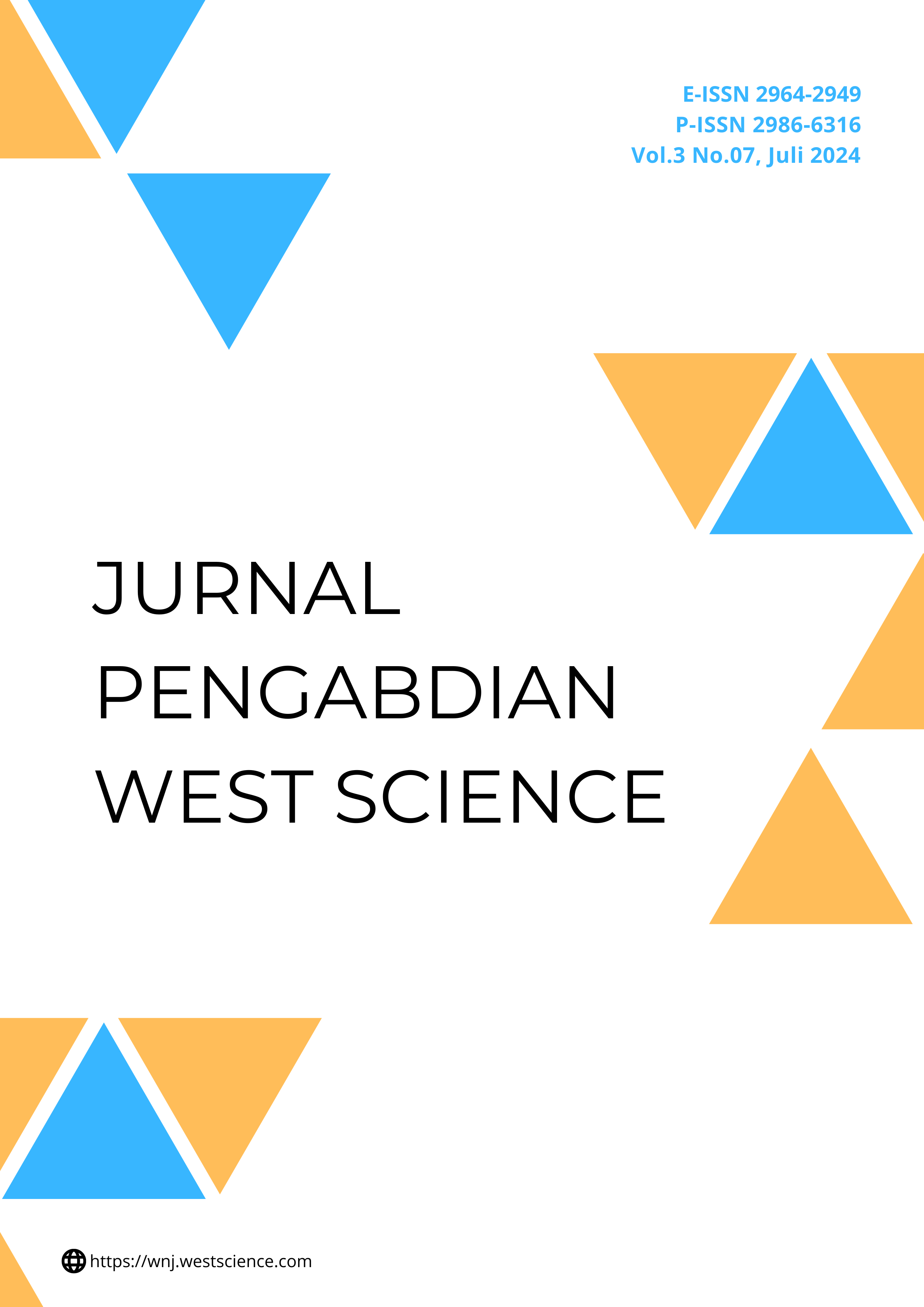Perencanaan dan Pelaksanaan Sumur Biopori sebagai Drainase Vertikal di RPTRA Menara dan Kelurahan Meruya Selatan
DOI:
https://doi.org/10.58812/jpws.v3i07.1363Kata Kunci:
Lubang Resapan Biopori, Drainase Perkotaan, Pengolahan Sampah Organik, Infiltrasi Air, Pelestarian LingkunganAbstrak
Urbanisasi pesat di Jakarta telah menyebabkan masalah drainase seperti genangan air dan banjir akibat curah hujan tinggi, penurunan permukaan tanah, dan perubahan tata guna lahan. Program pengabdian masyarakat ini mengusulkan penggunaan Lubang Resapan Biopori (LRB) sebagai solusi drainase vertikal yang inovatif dan berkelanjutan. LRB menggabungkan pengolahan sampah organik dengan peningkatan infiltrasi air, mengurangi genangan, dan memperbaiki kualitas air tanah. Implementasi LRB mudah, tidak memerlukan banyak ruang, dan memberikan manfaat ganda berupa pengurangan sampah organik dan peningkatan kesuburan tanah. Program ini juga meningkatkan partisipasi masyarakat dalam pengelolaan lingkungan, menawarkan solusi holistik untuk tantangan drainase perkotaan dan menciptakan lingkungan yang lebih sehat dan berkelanjutan.
Referensi
Abidin, H., Andreas, H., Gumilar, I., & Brinkman, J. (2015). Study on the risk and impacts of land subsidence in jakarta. Proceedings of the International Association of Hydrological Sciences, 372, 115-120. https://doi.org/10.5194/piahs-372-115-2015
Aulia, E. (2022). Kajian laju infiltrasi dengan teknik biopori di kecamatan seruway kabupaten aceh tamiang. Jurnal Ilmiah Mahasiswa Pertanian, 7(1), 624-630. https://doi.org/10.17969/jimfp.v7i1.18356
Budiyono, Y., Aerts, J., Tollenaar, D., & Ward, P. (2016). River flood risk in jakarta under scenarios of future change. Natural Hazards and Earth System Science, 16(3), 757-774. https://doi.org/10.5194/nhess-16-757-2016
Dwirahmadi, F., Rutherford, S., Phung, D., & Chu, C. (2019). Understanding the operational concept of a flood-resilient urban community in jakarta, indonesia, from the perspectives of disaster risk reduction, climate change adaptation and development agencies. International Journal of Environmental Research and Public Health, 16(20), 3993. https://doi.org/10.3390/ijerph16203993
Han, E., Kautz, T., Perkons, U., Uteau, D., Peth, S., Huang, N., … & Köpke, U. (2015). Root growth dynamics inside and outside of soil biopores as affected by crop sequence determined with the profile wall method. Biology and Fertility of Soils, 51(7), 847-856. https://doi.org/10.1007/s00374-015-1032-1
Ibrahim, I.N. et al. (2021) ‘An overview of the permeable reactive barrier as part of water remediation system in tropical countries’, IOP Conference Series: Earth and Environmental Science, 847(1), p. 012035. doi:10.1088/1755-1315/847/1/012035.
Indri, H., Yasnuar, M., & Efendi, M. (2016). Multi-criteria approach for designing sustainable drainage in malang residential area indonesia. Dimensi (Journal of Architecture and Built Environment), 43(1), 37-46. https://doi.org/10.9744/dimensi.43.1.37-46
Kautz, T. (2014). Research on subsoil biopores and their functions in organically managed soils: a review. Renewable Agriculture and Food Systems, 30(4), 318-327. https://doi.org/10.1017/s1742170513000549
Khusna, N., Sumarmi, S., Bachri, S., Astina, I., Nurhayati, D., & Shresthai, R. (2022). New technologies for project-based empathy learning in merdeka belajar (freedom to learn): the use of inarisk application and biopore technology. International Journal of Interactive Mobile Technologies (Ijim), 16(22), 94-110. https://doi.org/10.3991/ijim.v16i22.36153
Lubis, S., Hagos, S., Hermawan, E., Respati, M., Ridho, A., Paski, J., … & Permana, D. (2022). Record‐breaking precipitation in indonesia's capital of jakarta in early january 2020 linked to the northerly surge, equatorial waves, and mjo. Geophysical Research Letters, 49(22). https://doi.org/10.1029/2022gl101513
Luo, P., Kang, S., Zhou, M., Lyu, J., Aisyah, S., Binaya, M., … & Nover, D. (2019). Water quality trend assessment in jakarta: a rapidly growing asian megacity. Plos One, 14(7), e0219009. https://doi.org/10.1371/journal.pone.0219009
Marwanto, A. (2023). Pemanfaatan lubang biopori sebagai sistem drainase dan kompos alami di sd 2 kota bengkulu. Jurnal Kreativitas Pengabdian Kepada Masyarakat (Pkm), 6(9), 3833-3840. https://doi.org/10.33024/jkpm.v6i9.11164
Mulyawati, I. (2021). Community empowerment at nanggerang village in reducing potential flood through biopore infiltration hole (lrb) training and development. Iccd, 3(1), 251-253. https://doi.org/10.33068/iccd.vol3.iss1.352
Nurabriansyah, R. (2024). Analysis of compound flooding in the cakung drain area, dki jakarta province. E3s Web of Conferences, 500, 02016. https://doi.org/10.1051/e3sconf/202450002016
Pratiwi, D., Fitri, A., Phelia, A., Adma, N., & Kastamto, N. (2021). Analysis of urban flood using synthetic unit hydrograph (suh) and flood mitigation strategies along way halim river: a case study on seroja street, tanjung senang district. E3s Web of Conferences, 331, 07015. https://doi.org/10.1051/e3sconf/202133107015
Putri, R., Rostika, M., Abadi, A., & Rakhmatika, M. (2021). A review disaster mitigation of jakarta land subsidence areas. E3s Web of Conferences, 325, 01002. https://doi.org/10.1051/e3sconf/202132501002
Rachmawati, R. (2024). Achieving sustainable urban development for indonesia's new capital city. International Journal of Sustainable Development and Planning, 19(2). https://doi.org/10.18280/ijsdp.190204
Safriani, E., Halimah, A., & Wibowo, Y. (2020). Hydrology modelling-based biopore infiltration holes (bih) determination as river flood disaster mitigation in sewu village, surakarta, central java, indonesia. Jurnal Geografi Media Informasi Pengembangan Dan Profesi Kegeografian, 17(1), 27-31. https://doi.org/10.15294/jg.v17i1.22377
Surya, M., He, Z., Xia, Y., & Li, L. (2019). Impacts of sea level rise and river discharge on the hydrodynamics characteristics of jakarta bay (indonesia). Water, 11(7), 1384. https://doi.org/10.3390/w11071384
Verasta, T., Maulidin, I., Azzahra, H., Sobri, A., & Utami, A. (2021). The effect of greenhouse and biopore on community development of economy and knowledge of citeureup village during the pandemic. Journal of Innovation and Community Engagement, 2(1), 21-34. https://doi.org/10.28932/jice.v2i1.3603
Wendel, A., Bauke, S., Amelung, W., & Knief, C. (2022). Root-rhizosphere-soil interactions in biopores. Plant and Soil, 475(1-2), 253-277. https://doi.org/10.1007/s11104-022-05406-4
Wuryanta, A. (2022). Study of ecodrainage system for hydrometeorological disaster mitigation. Iop Conference Series Earth and Environmental Science, 1109(1), 012029. https://doi.org/10.1088/1755-1315/1109/1/012029
Zhang, Z., Yan, L., Wang, Y., Ruan, R., Xiong, P., & Peng, X. (2022). Bio‐tillage improves soil physical properties and maize growth in a compacted vertisol by cover crops. Soil Science Society of America Journal, 86(2), 324-337. https://doi.org/10.1002/saj2.20368
Unduhan
Diterbitkan
Cara Mengutip
Terbitan
Bagian
Lisensi
Hak Cipta (c) 2024 Erlangga Rizqi Fitriansyah, Suci Putri Elza

Artikel ini berlisensiCreative Commons Attribution-ShareAlike 4.0 International License.



















 Instagram
Instagram 